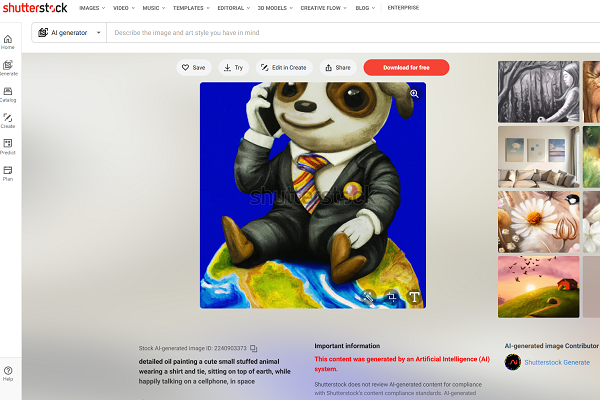Shutterstock Launches AI Text-to-Image Generator Powered by OpenAI’s DALL-E

Stock image service Shutterstock has released a text-to-image generator for its platform using OpenAI’s DALL-E 2 engine. The new synthetic media service is custom-trained on the Shutterstock image library, with royalties paid to the artists whose work was used in the process, as opposed to the open-source databases used by rival AI model Stable Diffusion.
Shutterstock Image AI
Shutterstock integrated its variant of the text-to-image generator from an API into its Creative Flow online design platform. Users can describe the image they want in the text box, and the AI will leverage the Shutterstock library it was trained on to create the visual. The result is attributed to “Shutterstock Generator” but is immediately available to license by anyone. Creators whose work went into the training database are being compensated, though the specifics of how they were chosen, how much they are getting, and how the royalties would be measured. No AI engine has demonstrated the ability to connect a generated image to specific parts of a database as of yet.
Still, Shutterstock has reason to be confident that it will benefit from providing the text-to-image service after surveying more than 3,000 customers and contributors. The company discovered 45% of customers and 35% of contributors were already using generative AI, nearly a third of each group citing work as the reason they used the technology. OpenAI benefits not only from scoring a major customer, but it can now leverage Shutterstock’s proprietary data to better train DALL-E. Shutterstock’s data is also part of its recently announced arrangements with LG AI Research, Meta, which will apply Shutterstock’s media libraries to train their own generative AI models.
“Shutterstock has developed strategic partnerships over the past two years with key industry players like OpenAI, Meta, and LG AI Research to fuel their generative AI research efforts, and we are now able to uniquely bring responsibly-produced generative AI capabilities to our own customers,” Shutterstock CEO Paul Hennessy said. “Our easy-to-use generative platform will transform the way people tell their stories — you no longer have to be a design expert or have access to a creative team to create exceptional work. Our tools are built on an ethical approach and on a library of assets that represents the diverse world we live in, and we ensure that the artists whose works contributed to the development of these models are recognized and rewarded.”
Shutterstock highlighted its training method and artist compensation plan as central to producing ‘ethically created visuals.’ That may help it dodge copyright and intellectual property violation claims, a facet of generative AI that’s beginning to receive intense legal scrutiny. Getty Images filed a complaint against generative AI service and Stabe Diffusion creator Stability AI about exactly that with London’s High Court of Justice last week. Getty was only a few days behind a group of artists who lodged a class action lawsuit in California against Stability AI, along with Stable Diffusion platforms Midjourney and DeviantArt. In both cases, the issues arise from the copyrighted images amongst the billions of pictures used to train Stable Diffusion. That includes the open-source LAION-5B dataset AI model and the images Stability scraped from the web, including Getty’s servers, without their creators’ awareness.
Follow @voicebotaiFollow @erichschwartz
Getty Images Sues Stability AI for Generative AI Art’s Alleged Copyright Violations
Shutterstock Will Integrate OpenAI’s DALL-E Synthetic Media AI Content
Shutterstock and LG Partner to Embed AI Stock Photo Text-to-Image and Image-to-Text Tool








